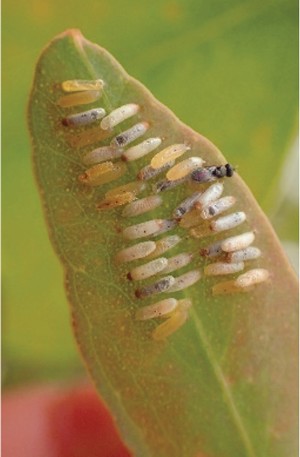PESTS AND DISEASES OF FORESTRY IN NEW ZEALAND
Update on eucalyptus variegated beetle (EVB), Paropsisterna variicollis
Scion is the leading provider of forest-related knowledge in New Zealand
Formerly known as the Forest Research Institute, Scion has been a leader in research relating to forest health for over 50 years. The Rotorua-based Crown Research Institute continues to provide science that will protect all forests from damage caused by insect pests, pathogens and weeds. The information presented below arises from these research activities.
From Forest Health News 287, March 2019.

Image: Huimin Lin (University of Canterbury).
This eucalyptus-feeding paropsine beetle pest, first reported in New Zealand in 2016, was reported from the South Island – from Nelson and Marlborough – for the first time this summer. It has also spread up the east coast of the North Island from Hawke’s Bay and is now established in Gisborne. Disappointingly for Eucalyptus growers, this beetle is proving to have a strong appetite for several species in the subgenus symphyomyrtus, including E. bosistoana, E. quadrangulata and E. nitens.
Field collections confirm the tortoise beetle egg parasitoid, Enoggera nassaui, that was introduced into New Zealand in to control Paropsis charybdis, does also attack EVB eggs, but at low rates. EVB and tortoise beetle, although being in two separate genera, are very closely related, as both are in the paropsine “clade” native to Australia. Sadly, due to its smaller size, EVB is a poor host for this egg parasitoid. Emerging adult parasitoids are one third to half the size of those that emerge from eggs of Paropsis charybdis, which likely means they will be less fecund (produce less eggs).
Toni Withers (Scion)
This information is intended for general interest only. It is not intended to be a substitute for specific specialist advice on any matter and should not be relied on for that purpose. Scion will not be liable for any direct, indirect, incidental, special, consequential or exemplary damages, loss of profits, or any other intangible losses that result from using the information provided on this site.
(Scion is the trading name of the New Zealand Forest Research Institute Limited.)

 Farm Forestry New Zealand
Farm Forestry New Zealand

